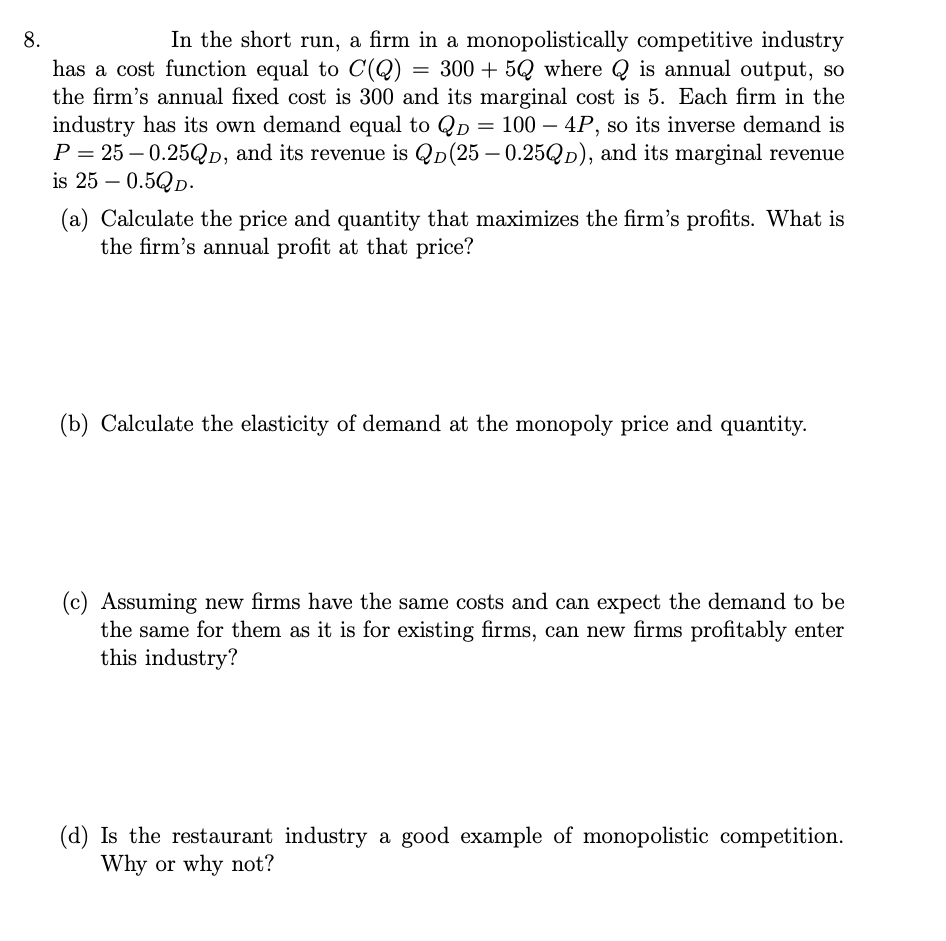In the short run, a firm in a monopolistically competitive industry has a cost function equal to C(Q) = 300 + 5Q where Q is annual output, so the firm's annual fixed cost is 300 and its marginal cost is 5. Each firm in the industry has its own demand equal to QD = 100 – 4P, so its inverse demand is P = 25 – 0.25QD, and its revenue is Qp(25 – 0.25QD), and its marginal revenue is 25 – 0.5QD. %3D (a) Calculate the price and quantity that maximizes the firm's profits. What is the firm's annual profit at that price? (b) Calculate the elasticity of demand at the monopoly price and quantity. (c) Assuming new firms have the same costs and can expect the demand to be the same for them as it is for existing firms, can new firms profitably enter this industry?
In the short run, a firm in a monopolistically competitive industry has a cost function equal to C(Q) = 300 + 5Q where Q is annual output, so the firm's annual fixed cost is 300 and its marginal cost is 5. Each firm in the industry has its own demand equal to QD = 100 – 4P, so its inverse demand is P = 25 – 0.25QD, and its revenue is Qp(25 – 0.25QD), and its marginal revenue is 25 – 0.5QD. %3D (a) Calculate the price and quantity that maximizes the firm's profits. What is the firm's annual profit at that price? (b) Calculate the elasticity of demand at the monopoly price and quantity. (c) Assuming new firms have the same costs and can expect the demand to be the same for them as it is for existing firms, can new firms profitably enter this industry?
Principles of Economics, 7th Edition (MindTap Course List)
7th Edition
ISBN:9781285165875
Author:N. Gregory Mankiw
Publisher:N. Gregory Mankiw
Chapter16: Monopolistic Competition
Section: Chapter Questions
Problem 4PA
Related questions
Question

Transcribed Image Text:8.
In the short run, a firm in a monopolistically competitive industry
has a cost function equal to C(Q) = 300 + 5Q where Q is annual output, so
the firm's annual fixed cost is 300 and its marginal cost is 5. Each firm in the
industry has its own demand equal to QD = 100 – 4P, so its inverse demand is
P = 25 – 0.25QD, and its revenue is Qp(25 – 0.25QD), and its marginal revenue
is 25 – 0.5QD.
(a) Calculate the price and quantity that maximizes the firm's profits. What is
the firm's annual profit at that price?
(b) Calculate the elasticity of demand at the monopoly price and quantity.
(c) Assuming new firms have the same costs and can expect the demand to be
the same for them as it is for existing firms, can new firms profitably enter
this industry?
(d) Is the restaurant industry a good example of monopolistic competition.
Why or why not?
Expert Solution
This question has been solved!
Explore an expertly crafted, step-by-step solution for a thorough understanding of key concepts.
Step by step
Solved in 2 steps

Knowledge Booster
Learn more about
Need a deep-dive on the concept behind this application? Look no further. Learn more about this topic, economics and related others by exploring similar questions and additional content below.Recommended textbooks for you

Principles of Economics, 7th Edition (MindTap Cou…
Economics
ISBN:
9781285165875
Author:
N. Gregory Mankiw
Publisher:
Cengage Learning

Principles of Economics (MindTap Course List)
Economics
ISBN:
9781305585126
Author:
N. Gregory Mankiw
Publisher:
Cengage Learning

Principles of Microeconomics (MindTap Course List)
Economics
ISBN:
9781305971493
Author:
N. Gregory Mankiw
Publisher:
Cengage Learning

Principles of Economics, 7th Edition (MindTap Cou…
Economics
ISBN:
9781285165875
Author:
N. Gregory Mankiw
Publisher:
Cengage Learning

Principles of Economics (MindTap Course List)
Economics
ISBN:
9781305585126
Author:
N. Gregory Mankiw
Publisher:
Cengage Learning

Principles of Microeconomics (MindTap Course List)
Economics
ISBN:
9781305971493
Author:
N. Gregory Mankiw
Publisher:
Cengage Learning

Principles of Microeconomics
Economics
ISBN:
9781305156050
Author:
N. Gregory Mankiw
Publisher:
Cengage Learning

